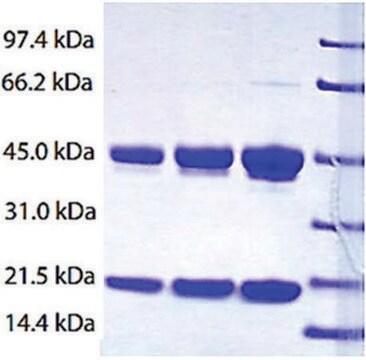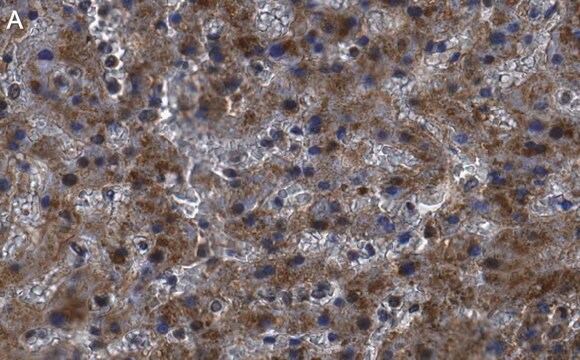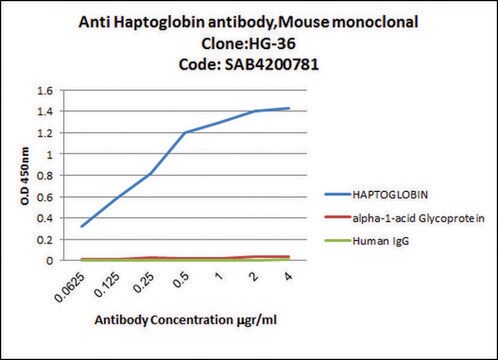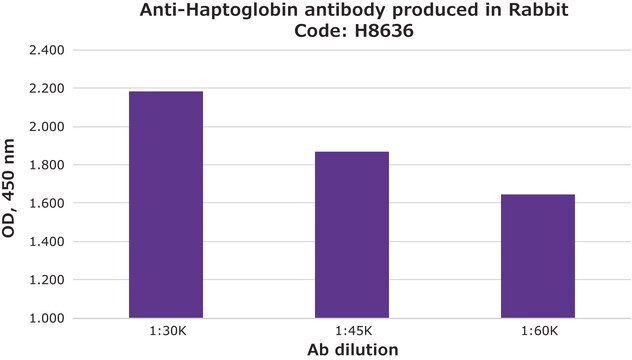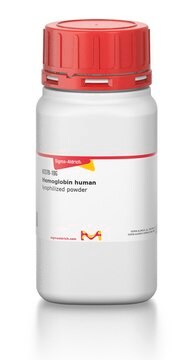H6395
Monoclonal Anti-Haptoglobin antibody produced in mouse
clone HG-36, ascites fluid
Autenticatiper visualizzare i prezzi riservati alla tua organizzazione & contrattuali
About This Item
Prodotti consigliati
Origine biologica
mouse
Livello qualitativo
Coniugato
unconjugated
Forma dell’anticorpo
ascites fluid
Tipo di anticorpo
primary antibodies
Clone
HG-36, monoclonal
contiene
15 mM sodium azide
Reattività contro le specie
human
tecniche
indirect ELISA: 1:4,000
Isotipo
IgG1
N° accesso UniProt
Condizioni di spedizione
dry ice
Temperatura di conservazione
−20°C
modifica post-traduzionali bersaglio
unmodified
Informazioni sul gene
human ... HP(3240)
Categorie correlate
Descrizione generale
Monoclonal anti-Human Haptoglobin (mouse IgG1 isotype) is derived from the hybridoma produced by the fusion of mouse myeloma cells and splenocytes from an immunized mouse. Haptoglobin (Hp) is a serum α 2-glycoprotein that exists as a tetramer, composed of two smaller identical α chains and two larger identical β chains. The α-chains are linked to each other by a disulfide bond and each β-chain is similarly linked to an α-chain. Plasma haptoglobin is structurally similar to serum immunoglobulins. Haptoglobin is found in normal plasma at a concentration of 0.3-1.9 mg/ml and accounts for 0.4-2.6% of the total plasma proteins. It is also one of the groups of plasma proteins known as acute phase reactants.
Specificità
The antibody is specific for the 3 major haplotypes of human haptoglobin (Types 1-1, 2-1 and 2-2). It does not cross-react with human IgG, transferrin, C-reactive protein, α1-acid glycoprotein, albumin or hemoglobin using ELISA or immunoblotting methods. The antibody recognizes human haptoglobin as purified antigen, in human serum, or when complexed with human hemoglobin in a native or denatured, but non-reduced state.
Applicazioni
Applications in which this antibody has been used successfully, and the associated peer-reviewed papers, are given below.
Western Blotting (1 paper)
Western Blotting (1 paper)
Monoclonal Anti-Haptoglobin antibody produced in mouse has been used in enzyme-linked immunosorbent assay (ELISA) to determine plasma haptoglobin (Hp) levels and to probe duplicate dot blot strips for dot blot assay. It has been used in affinity purification of human high-density lipoprotein (HDL) to obtain trypanosome lytic factor (TLF) and also to prepare an affinity resin.
Azioni biochim/fisiol
The most characteristic property of haptoglobin is its ability to form stable complexes with extra-corpuscular-free native hemoglobin that has been released during hemolysis and is thus thought to prevent iron loss through urinary excretion and to also prevent renal damage from the hemoglobin. In addition, the native form or normal plasma haptoglobin has been shown to exhibit a broad spectrum of immunosuppressive effects in the immune system. Measurement of haptoglobin levels may therefore be used to monitor the progress of inflammatory reactions and assess the efficiency of test drugs.
Esclusione di responsabilità
Unless otherwise stated in our catalog or other company documentation accompanying the product(s), our products are intended for research use only and are not to be used for any other purpose, which includes but is not limited to, unauthorized commercial uses, in vitro diagnostic uses, ex vivo or in vivo therapeutic uses or any type of consumption or application to humans or animals.
Non trovi il prodotto giusto?
Prova il nostro Motore di ricerca dei prodotti.
Codice della classe di stoccaggio
10 - Combustible liquids
Classe di pericolosità dell'acqua (WGK)
nwg
Punto d’infiammabilità (°F)
Not applicable
Punto d’infiammabilità (°C)
Not applicable
Scegli una delle versioni più recenti:
Possiedi già questo prodotto?
I documenti relativi ai prodotti acquistati recentemente sono disponibili nell’Archivio dei documenti.
Human plasma protein N-glycosylation
Clerc F, et al.
Glycoconjugate Journal, 33(3), 309-343 (2016)
A Zauberman et al.
The Journal of biological chemistry, 276(27), 24719-24725 (2001-05-02)
Activin A, a member of the transforming growth factor beta (TGFbeta) superfamily, blocks interleukin (IL)-6 biological functions. The molecular basis of the influence of this TGFbeta signaling on the IL-6 receptor triggered cascade is unknown. We studied IL-6-induced secretion of
Identification and purification of a hemoglobin-binding outer membrane protein from Neisseria gonorrhoeae.
Chen CJ, et al.
Infection and Immunity, 64(12), 5008-5014 (1996)
Plasma proteomic profile of sulfur mustard exposed lung diseases patients using 2-dimensional gel electrophoresis
Mehrani H, et al.
Clinical Proteomics, 8(1), 2-2 (2010)
Trypanosome lytic factor, an antimicrobial high-density lipoprotein, ameliorates Leishmania infection
Samanovic M, et al.
PLoS Pathogens, 5(1), e1000276-e1000276 (2009)
Il team dei nostri ricercatori vanta grande esperienza in tutte le aree della ricerca quali Life Science, scienza dei materiali, sintesi chimica, cromatografia, discipline analitiche, ecc..
Contatta l'Assistenza Tecnica.

